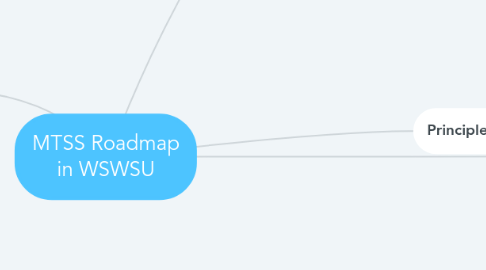
1. Template for next steps (who, when, how, connect to need/CIP, expected result);
2. Principles of MTSS
2.1. Principle 2 The highest quality classroom instruction supported by a standards-based curriculum.
2.2. Principle 1 Educators believe that all students learn and can achieve high standards.
2.3. Principle 3 Coherent, balanced assessment system guides responsive teaching, informs about progress, and leads to decisions.
2.4. Principle 5 Expert personnel provide targeted and differentiated instruction responsive to the need.
2.5. Principle 4 Analysis/use of data to monitor progress, inform instruction, and refine goal-setting to accelerate student learning.
2.6. Principle 6 Schools provide a comprehensive, responsive system of instruction and intervention.
2.7. Principle 7 Collaboration among students, families, and professionals
2.8. Principle 8 Effective leadership, including building administrator engagement and distributed leadership.
2.8.1. ATM uses subcommittees to advance initiatives
2.8.2. Schools use leadership teams or teacher leaders/committees to manage MTSS and advance initiatives for improvement
2.8.3. May involve redefining roles, titles; or adding personnel.
2.9. Principle 9 Continuously-developing expertise; professional development to build capacity and sustain progress.
2.9.1. SU, building-based, and supplemental PD focused on CIP goals in Academic Proficiency, Personalization and Safe & Healthy Schools
2.9.2. Mentoring program includes training/support in CIP goals for new teachers
2.9.3. Becca & Mike: How will we change SU-wide model to cater to different PD needs. Maybe all won't be doing the same things on PD days.
2.10. Principle 10 Coherent plan for continuous improvement including recursive assessment, reflection, and adaptation.
2.10.1. CIP includes MTSS improvement
2.10.1.1. CIP Goal 1 includes improvement in multiple tiers
2.10.1.2. CIP Goal 3 (Safe & Healthy Schools) focuses on trauma informed school practices and social emotional learning, as well as community outreach.
2.10.1.3. Choosing common and school specific milestones to focus upon and set goals around will help narrow/specify and schedule our CIP w/r/t MTSS
3. MTSS Milestones
3.1. Clear, Articulated (& Prioritized) Learning Intentions/Outcomes
3.1.1. Common K-8 Report Card Items;
3.1.2. Performance Indicators in Proficiency Based Graduation Requirements attached to MHS courses
3.1.3. Lesson Frames reflect/connect (Fun 5)
3.1.3.1. Rigor, general Tier 1 (fun5)
3.1.3.2. Relevance, general Tier 1 (fun5)
3.1.4. Prioritize High Leverage Concepts in each core academic area (priority proficiencies)
3.1.4.1. Build common formative/summative assessments for priority standards; to inform instruction
3.1.4.2. Build intervention toolkits specific to priority standards
3.1.4.3. Examine existing curricula to find where priority standards live; adjust to spend sufficient time on priority standards
3.2. Intervention Menus
3.2.1. Each school creates them; not all the same content/interventions yet
3.3. Every Teacher is an Interventionist
3.3.1. Training for expertise in content area(s); esp. basic reading, writing, math
3.4. Social Emotional Learning Curriculum/Practices
3.4.1. Curriculum
3.4.1.1. What
3.4.1.1.1. Explicitly teach prosocial skills/ approaches to learning
3.4.1.2. When/Where
3.4.1.3. By whom
3.4.2. Social Emotional Learning Teaching Practices
3.4.2.1. Teacher/Adult Practices
3.4.2.1.1. Zones of Regulation
3.4.2.1.2. Mindfulness
3.4.2.1.3. Restorative Practices
3.4.2.1.4. Executive Functioning
3.4.2.1.5. De-stress, de-escalation
3.5. Content Area specialists k-5
3.5.1. Each elementary school tailors this to local need/population
3.6. Define the Instructional Block
3.6.1. Done by teachers as specialists with consultant(s)
3.7. SCHEDULING
3.7.1. Intervention time (incl. in instruction block)
3.7.2. Team Time
3.7.2.1. academic/behavior data teams
3.7.2.2. various leadership teams
3.7.3. PD, instructional rounds, coaching, mentoring
3.8. Social Emotional Learning Systems
3.8.1. Responsive Classroom
3.8.2. PBIS
3.9. Data Analysis Tools, Academic
3.9.1. Academic data
3.9.1.1. What
3.9.1.1.1. Universal Screener
3.9.1.1.2. Diagnostic, Math/ELA
3.9.1.1.3. Progress Monitoring, ELA/Math
3.9.1.1.4. Benchmarks, ELA/Math
3.9.1.2. How
3.9.1.2.1. Data team time scheduled
3.9.1.2.2. teacher/team capacity, training
3.9.1.2.3. Tool(s), training on tools
3.9.1.2.4. Informs Tier 1, 2, 3 instruction
3.9.1.2.5. Goal setting TO CLOSE GAPS
3.9.1.3. By whom
3.10. Data Analysis Tools, Behavior
3.10.1. Behavior Data
3.10.1.1. What
3.10.1.2. How (collection, data sharing)
3.10.1.3. By whom
3.11. Trauma, SEL/Behavior services
3.11.1. Guidance counselor
3.11.2. Behavior Analysts
3.11.2.1. PBIS Analyst euphemism
3.11.3. Social worker, services
3.11.4. Mental health / behavior counseling
3.11.5. Mental Health Clinician
3.11.6. Example: Paine Mt. Student Support Roles (link)
